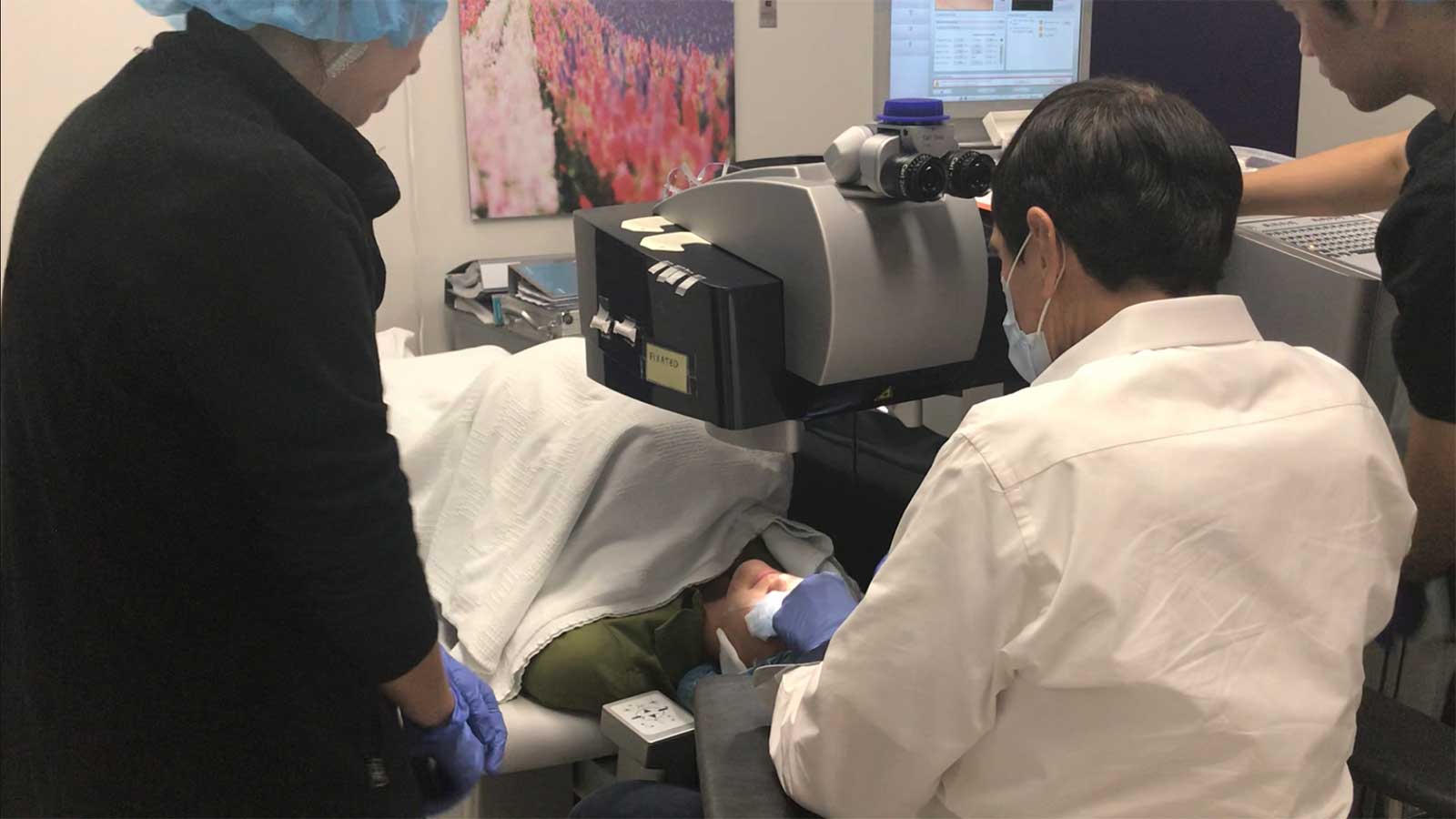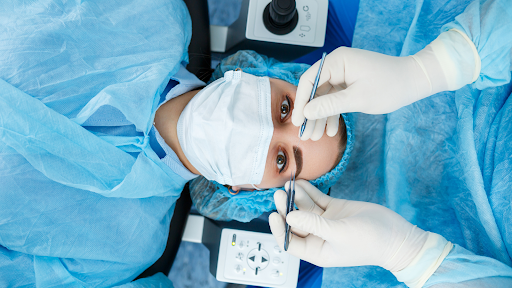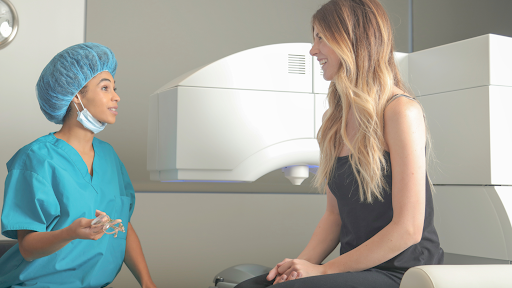LASIK eye surgery stands out as a top-of-mind choice and a beacon of modern medical miracles when finding ways to achieve perfect vision. It offers a life-changing solution for people suffering from the constraints of glasses or contact lenses. However, the lifelong question remains – “does LASIK surgery hurt?”
This comprehensive blog will provide an in-depth look into LASIK surgery, addressing common concerns, debunking myths, and guiding you through achieving clearer vision without undue pain or discomfort. Make sure to read until the end!
Understanding LASIK Surgery
In a nutshell, LASIK eye surgery is a transformative medical procedure that can correct a patient’s vision. It is both a marvel of medical technology and a testament to the advancements in eye care. We’ll guide your understanding of LASIK as we delve deeper into its technological milestones.
What is LASIK Surgery?
At its core, LASIK eye surgery is a procedure aimed at correcting refractive errors such as myopia (nearsightedness), hyperopia (farsightedness), and astigmatism. The goal is to reshape the cornea—the eye’s clear front surface—so that light entering the eye can be properly focused onto the retina, resulting in clearer vision. LASIK Surgery is achieved through a specialized laser that alters the cornea’s curvature meticulously.
Hearing all that, especially about its nature of being a laser surgery, you might naturally elicit concerns about the pain it can bring and its safety. However, LASIK has evolved into one of the most well-tolerated and successful corrective vision surgeries, with millions of patients worldwide experiencing life-changing results.
The procedure itself is surprisingly quick, often completed in under 30 minutes for both eyes and is performed under local anesthesia to ensure that patients are comfortable and pain-free throughout.
The Evolution of LASIK Technology
Like any other technological advancement, LASIK technology’s journey from an experimental procedure to a highly refined and widely accepted procedure for correcting vision is a fascinating story worth knowing and telling. Initially, the concept of LASIK was met with skepticism, but today, it is considered one of the most seamless medical procedures that only cause minimal to no pain or discomfort.
For better context, here are the detailed evolution of LASIK technology:
- First-generation LASIK utilized a mechanical blade (microkeratome) to create the corneal flap, a necessary step in the procedure. While effective, this method posed a higher risk of complications and outcome variability.
- The advent of femtosecond lasers transformed the procedure by allowing surgeons to create the corneal flap with unparalleled precision and consistency, significantly reducing risks and improving patient comfort.
- Wavefront technology further enhanced LASIK’s outcomes by enabling custom correction based on detailed maps of the patient’s eye, addressing unique imperfections and achieving sharper vision than ever before.
These technological milestones have not only improved the safety and effectiveness of LASIK but have also played a critical role in minimizing discomfort during and after the procedure, addressing the common concern of “Does LASIK hurt?” with a resounding emphasis on patient comfort.
The LASIK Procedure Explained
When conscious about the potential pain level of LASIK surgery, it is crucial to understand its overall procedure as it will give you the clarity and assurance you need. Here’s what you can expect:
Preparations and Expectations
The LASIK surgery journey begins with a comprehensive evaluation by a qualified LASIK eye surgeon like Dr. Charles Manger. This part of the procedure assesses your vision and eyes’ health and determines your suitability for LASIK eye surgery. It’s also an opportunity to discuss expectations addressing any questions or concerns you may have – chief among them, “Does LASIK surgery hurt?”
Being in this stage and understanding what to expect during and after the procedure is a critical step in preparation. This is where you’ll be advised on how to prepare for surgery, including guidelines on eating, drinking, and medication use. Knowledge of these details will allow you to physically and mentally prepare, building your confidence in the process.
Step-by-Step: What Happens During LASIK?
Whether others deny it or not, LASIK surgery is designed for efficiency and patient comfort. Here’s a closer look at what happens during the surgery:
- Initial Examination: Before the surgery, the surgeon checks your eye’s measurements and discusses the procedure with you.
- Anesthetic Drops: Numbing drops are applied to your eyes, ensuring you feel no pain during the procedure. Some patients report a slight pressure sensation, but discomfort is minimal.
- Corneal Flap Creation: The surgeon creates a thin flap in the cornea using either a femtosecond laser or a microkeratome. This step is crucial for accessing the underlying corneal tissue.
- Reshaping the Cornea: With the flap gently lifted, the excimer laser is used to reshape the cornea based on the specific measurements of your eye. This part of the procedure is quick and painless.
- Flap Reapplication: After the cornea is reshaped, the flap is carefully laid back where it naturally adheres to the eye, healing over time without stitches.
Immediate Post-Op Care
After your LASIK surgery, it’s common to feel a bit of burning or itching as the numbness fades, alongside temporary blurry vision. Don’t worry – this usually gets much better within a day. You’ll need to wear some protective eyewear to keep your eyes safe from bright lights and advised to take it easy for the day. The next day, you’ll have a check-up to ensure everything’s healing up nicely and that any discomfort, which is generally relatively mild, is discussed.
This detailed walkthrough of the LASIK procedure underscores the advancements and precautions taken to ensure patient safety and comfort, significantly reducing concerns surrounding the question, “Does LASIK hurt after?” With a clearer understanding of what to expect, potential patients can confidently approach the decision and anticipate life beyond glasses or contact lenses.
Pain and Discomfort: What Patients Can Expect
If you’re still worried about the pain and discomfort that LASIK surgery can bring, it’s perfectly fine! It’s natural to have concerns about pain when considering any surgical procedure. This section sheds light on what patients can realistically expect regarding sensations during and after the surgery.
Sensations and Anesthetics
The quick answer to the lifelong question of “Does LASIK hurt?” is it DOESN’T – and this is all thanks to anesthetic eye drops that are not generally painful when administered in your eyes. You’ll only feel a little pressure, but rest assured that you won’t experience any pain levels.
Typical Discomfort and Its Duration
After the procedure, as the anesthesia wears off, it’s common for patients to experience some level of discomfort. However, the question of “Does LASIK hurt after?” is a concern that many find to be less daunting once you understand what to expect:
- Mild Irritation: A gritty sensation or the feeling of having an eyelash in the eye is common but typically subsides within a few hours to a couple of days.
- Light Sensitivity: Increased sensitivity to light can be expected but diminishes quickly.
- Dry Eyes: A temporary increase in eye dryness is a common post-operative symptom, usually managed effectively with lubricating eye drops.
Generally, the discomfort experienced by most patients is manageable and short-lived, but it is essential to communicate with your surgeon if you feel other types of discomfort.
Addressing Common Concerns About LASIK Pain
One of the factors that amplifies fear and shared concerns about LASIK pain is unnecessary information that spreads around. That said, let’s address some of these misconceptions and clarify what truly is the correct information to take about LASIK surgery. Let’s dive in!
Myths vs. Reality: Clarifying Misconceptions
1. Myth: LASIK is a painful surgery.
2. Reality: LASIK involves minimal discomfort during and after the procedure, with most patients experiencing only mild, temporary irritation or dryness.
3. Myth: Recovery from a LASIK surgery is long and painful.
1. Reality: Recovery is remarkably swift, with most patients resuming normal activities within a day or two, experiencing only mild discomfort that is easily managed.
4. Myth: The laser used in LASIK causes pain.
1. Reality: The laser itself is painless; discomfort may arise from the pressure of the device to stabilize the eye, but this is brief and managed with anesthetic drops.
These are just a few of the many scenarios that revolve around LASIK surgery. Remember not to be daunted when faced with information that sounds like a myth. Consult a professional LASIK doctor for any inquiries and concerns you may have.
The Role of Anxiety in Perceived Pain
Another significant factor that influences one’s perception of pain is anxiety – and this factor is highly understandable. There are many ways to counter the feeling of being anxious to proceed with your LASIK surgery, but the best is understanding the procedure.
Once equipped with the proper knowledge, you’ll realize how safe and painless LASIK surgery is, and hopefully, it can minimize the anxiety and discomfort that you may have. Trusting in the advanced technology for LASIK surgery and the surgeon’s skill will always be your driving force to counter the perceived pain of LASIK.
Advanced Technologies Reducing Pain in LASIK
Innovations in LASIK technology have been pivotal in enhancing patient comfort and reducing discomfort during and after the procedure. In simpler terms, LASIK became more seamless, painless, and safer as technology advances.
Innovations in LASIK
Technological advancements in LASIK surgery have focused on precision, safety, and reducing patient discomfort. The use of femtosecond lasers for creating the corneal flap and wavefront-guided lasers for corneal reshaping are significant improvements that have made the procedure smoother and more comfortable.
How Modern LASIK Techniques Enhance Comfort
If you’re wondering about the technicalities of how modern LASIK technology enhances comfort, then read the two pivotal pointers below:
- Femtosecond Laser: By making the flap creation process bladeless, this laser reduces the risk of complications and discomfort associated with mechanical methods.
- Customized Treatment Plans: Wavefront technology allows for a highly customized treatment, reducing the chance of post-surgery issues like glare or halos, which can contribute to discomfort.
These state-of-the-art solutions seamlessly blend efficiency, safety, and overall patient experience.
Tips for a Smooth Recovery After LASIK
Ensuring a smooth recovery after a LASIK surgery is a holistic approach to mitigate your possible fear of pain. Here are some of the best essential tips you can do after your surgery:
Do’s and Don’ts After Your Surgery
Grab a pen and a note, and absorb these valuable dos and don’ts after a procedure to reduce your discomfort about the LASIK eye surgery.
- Do:
- Use all prescribed eye drops to prevent infection and inflammation.
- Rest your eyes as much as possible on the day of the surgery.
- Attend all follow-up appointments with your surgeon.
- Prevent accidental rubbing or pressure on your eyes while sleeping.
- Follow a balanced diet rich in vitamins and antioxidants to support eye healing.
- Don’t:
- Rub or press on your eyes, which can dislodge the corneal flap.
- Participate in contact sports or activities that pose a risk to your eyes for at least a month.
- Expose your eyes to irritants such as dust and smoke during the initial recovery period.
- Swim or use hot tubs for at least two weeks after surgery.
- Use makeup around the eyes for at least a week to prevent infection and irritation.
If you ask yourself, “Does LASIK hurt after its treatment?” the answer is no. But following these dos and don’ts is highly recommended to make things safe and secure.
Frequently Asked Questions About LASIK Pain
Let’s address some frequently asked questions that might still linger regarding LASIK and discomfort.
-
Is LASIK Pain Tolerable?
-
-
- Yes, any discomfort during and after LASIK is typically mild and temporary. The procedure is painless, thanks to numbing drops and innovative technology.
-
-
How Long Does Discomfort Last?
-
-
- Most patients report that any post-operative discomfort subsides within a few hours to a few days. Symptoms like dry eyes may persist longer but gradually improve over weeks to months.
-
-
Can Pain Affect the Outcome of LASIK?
-
-
- Pain is not an expected outcome of LASIK and rarely affects the long-term results of the surgery. Just ensure to follow your surgeon’s post-operative care instructions.
-
-
What Should I Do If I Experience Severe Pain After LASIK?
-
- Severe pain after LASIK is rare. However, you must contact your LASIK surgeon immediately if you experience significant discomfort or any symptoms.
Book Your Painless LASIK Surgery with Saddleback Eye Center
Choosing Saddleback Eye Center means entrusting your eyes to one of the world’s most experienced LASIK eye surgeons. With advanced technology, including eight different lasers and a professional staff dedicated to your care, we ensure a painless procedure with exceptional outcomes.
Book your consultation today and see why patients from across the globe choose Dr. Manger at Saddleback Eye Center for their vision correction needs.





